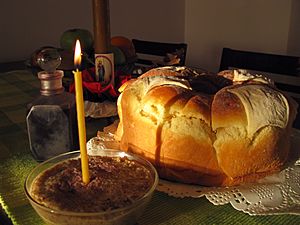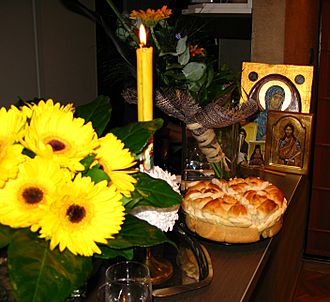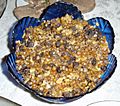Slava (tradition) facts for kids
Quick facts for kids SlavaСлава |
|
|---|---|
|
UNESCO Intangible Cultural Heritage
|
|

Slava prepared for the veneration of John the Baptist
|
|
| Country | Serbia |
| Domains | Ritual, Celebration, Religious practice |
| Reference | 01010 |
| Region | Europe and North America |
| Inscription history | |
| Inscription | 2014 (9th session) |
| List | Intangible Cultural Heritage of Humanity |
| Slava | |
|---|---|

Slava prepared for the veneration of Saints
|
|
| Observed by | Serbian Orthodox Christians |
| Significance | Veneration of the family's patron saint |
| Observances | Church services, family and other social gatherings |
| Date | Lua error in Module:Wikidata at line 132: attempt to index field 'wikibase' (a nil value). |
Slava (Serbian Cyrillic: Слава, lit. 'Glory, Celebration', pronounced [ˈslâʋa]) is a special tradition where a family honors its patron saint. It is mainly celebrated by Serbian Orthodox Christians. Families celebrate Slava once a year on their saint's special day. In 2014, UNESCO added Slava to its list of important cultural heritage from Serbia.
Contents
What is Slava?
Slava is a yearly family celebration to honor a family's special patron saint. It remembers the first ancestor in the family who became a Christian. The family's patron saint is passed down from father to son. Only men usually lead the Slava traditions.
When women get married, they usually start celebrating their husband's family saint. However, some women also keep celebrating their own family's saint. This second celebration is called preslava.
Friends and family gather at home for a special meal. Even though it is a religious event, families celebrate Slava for "the good health of those living" and to "remember family members who have passed away."
This tradition is a very important part of Serbian identity. A famous saying is: Где је слава, ту је Србин (meaning "Where there is a Slava, there is a Serb"). This saying was made popular by Miloš Milojević in the late 1800s. Serbs often see Slava as their most important and special holiday. Serbs living all over the world also keep this tradition alive.
Besides Serbia, Slava is also common in places where the Serbian medieval state once had influence. You can find similar traditions among Montenegrins, Macedonians, and sometimes among Croats. It is also celebrated by Catholics in places like Boka Kotorska and Southern Herzegovina. Christians in Northern Albania and some Muslims among Gorani and Bosniaks in Bosnia also have similar customs. A similar tradition is also found in Western Bulgaria and among some Vlachs and Aromanians.
History of Slava

Historians believe that Serbs have been celebrating Slava since at least the year 1018.
The tradition began in Medieval Serbia. It is linked to Saint Sava, who was the first Archbishop of the Serbs. Some believe that Saint Sava helped create the Slava tradition. He found a way to combine older Serbian beliefs with Christian teachings. The Slava is like a new version of an old Serbian custom. In this new version, an ancestor-protector became a Christian saint, often St. Nicholas. The old customs became more about social gatherings and family meetings.
Some researchers have different ideas about the exact history of Slava. They discuss how it became a symbol of Serbian identity.
Slava Today
After World War II, many people moved from farms to cities. Also, during the Communist rule, it was harder to openly celebrate Serbian Orthodox traditions. Because of this, some parts of the Slava custom became more flexible. For example, families sometimes had to celebrate Slava in more than one place if family members lived far apart.
Even though it was difficult during the Communist period, Slava remained popular. After the Communist rule ended, Serbian Orthodox traditions became popular again, and Slava saw a big comeback. It is now seen as a special Serbian custom. Today, even people who are not very religious or are atheists often celebrate Slava. They see it as a family holiday passed down through generations and a way to show their cultural identity.
The custom also helps families trace their history and connections to different regions. It shows how Serbs connect their national and spiritual identity. It is a core part of how Serbs understand their culture and reality, celebrated every year.
In November 2014, Slava was added to the UNESCO Intangible Cultural Heritage Lists for Serbia.
How Slava is Celebrated
Где је слава, ту је Србин
Gde je slava, tu je Srbin
Where there is a Slava, there is a Serb—Miloš Milojević
Two important foods for the Slava feast are the slavski kolač (a special bread) and koljivo (also called žito). Koljivo is a dish made from boiled wheat, sweetened, and sometimes mixed with walnuts. A beeswax candle with a picture of the saint is also important.
Before the Slava, a priest visits the home and blesses it with family members present. This happens in front of the saint's icon and the lit candle, while the priest says a prayer. Then, every room in the house is sprinkled with holy water. The family members are also blessed, and the priest wishes them good health.
The top of the kolač bread is decorated with a Christian cross, a peace dove, and other symbols. The kolač stands for the body of Jesus, and the wine used with it stands for his blood. Traditionally, a woman would bake the bread the day before the celebration. She would bathe, wear clean clothes, say the Lord's Prayer, and make the sign of the cross.
The parish priest blesses the kolač with wine. After this, the woman of the house cuts it into four parts and turns it cut-side up. Other family members and important guests then cut it into smaller pieces. In some traditions, guests "break" the bread together after it has been ritually turned. The koljivo symbolizes the Resurrection of Christ. It is eaten to remember family members who have passed away.
The rest of the feast is a meal. What is served depends on whether the celebration falls during a period of fasting. During a fast (called post), the meal will not have any meat. It might include seafood. If it's not a fasting period, there are no such rules, and the Slava is called mrsna. So, people often say a Slava is posna (fasting) or mrsna (non-fasting). Special sweets are also eaten, and adults are served alcohol.
The most common feast days for Slava are St. Nicholas (Nikoljdan, December 19), St. George (Đurđevdan, May 6), St. John the Baptist (Jovanjdan, January 20), St. Demetrius (Mitrovdan, November 8), St. Michael (Aranđelovdan, November 21), and St. Sava (Savindan, January 27). These dates are given using the Gregorian calendar. The Serbian Orthodox Church uses the Julian calendar.
Many Serbian communities, like villages, cities, and organizations, also celebrate their own patron saint. For example, the city of Belgrade celebrates the Ascension of Jesus Christ as its patron saint's day.
Images for kids
-
Church prepared for the celebration of a Slava, Trebinje, Republika Srpska, Bosnia and Herzegovina.
Annotations
- Krsna slava (Крсна слава, "christened Slava") and Krsno ime (Крсно име, "christened name")
See also
 In Spanish: Slava para niños
In Spanish: Slava para niños






